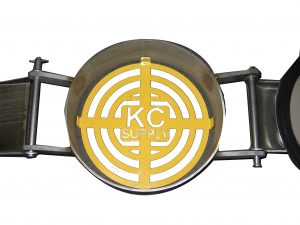Safety screens play an important role in protecting people from moving equipment. If you don’t have screens installed with your inspection and access doors, you should.


“Doors are used to ‘enter’ equipment to inspect or work on the internal components,” said Jeff Lavery, KC Supply Co. owner. “With inspection doors, screens are usually permanently attached so that a tool is not required to open the door because they just ‘look’ at the equipment without entering (with tool, hand or body). For access doors, the Occupational Safety and Health Administration (OSHA) requires a tool to open the door – or a safety screen to prevent someone from sticking their hand or tool inside the equipment while it is running, thus potentially resulting in an injury or amputation.”
According to OSHA, amputations are among the most severe and disabling workplace injuries because they often result in permanent disability. They are widespread and involve various activities and equipment, including saws, presses, conveyors, and bending, rolling or shaping machines as well as powered and non-powered hand tools, forklifts, doors, trash compactors and during materials-handling activities.
Workplace injuries resulted in nearly 3,000 amputations in 2015, OSHA reported. A 2016 OSHA report revealed that there were 10,388 severe injuries caused by workplace conditions in 2015. These injuries led to 7,636 hospitalizations and 2,644 amputations. OSHA collected the data from 26 states that have higher safety standards than those mandated by federal regulations.
The manufacturing industry saw the highest proportion of accidents – it accounted for 57 percent of all amputations and 26 percent of all hospitalizations. Among the other industries with high accident rates were construction, transportation and warehousing as well oil and gas extraction.
The OSHA rules on “Safeguarding Equipment and Protecting Employees from Amputations” (OSHA 3170-02R) is available at www.osha.gov/Publications/OSHA3170/3170-02R-2007-English.html. The U.S. Department of Labor Mine Safety and Health Administration (MSHA) has similar guidelines in place for moving machine part hazards.
Safety screens are a necessary part of any material-handling system to help prevent accidents. Consider that that conveyor belt moving at 300 feet per minute – or 5 feet per second – will you’re your tool, your loose clothing, your hand or your arm 5 feet into the pinch point before you can even react.
Do you have questions regarding safety screens? Please let KC Supply help you make your workplace safer for your employees. KC Supply provides screens for several brands of doors, including Tsubaki, PS Doors, Civacon and Knappco brands. Call KC Supply Co. today at 800.KCSUPPLY and let us answer all your questions and help you determine which safety screens are right for your equipment and facility. Visit www.kcsupply.com for more information.


